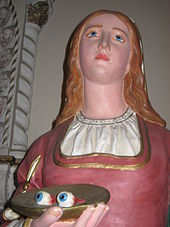 The Annual Arlington Community “Santa Lucia Festival of Lights”, which will benefit the Arlington Food Shelf and the Hurricane Irene Relief Fund, are looking for children to volunteer for the fesitval. The fesitval will take place on Saturday, Dec. 10, at 5 p.m.
The Annual Arlington Community “Santa Lucia Festival of Lights”, which will benefit the Arlington Food Shelf and the Hurricane Irene Relief Fund, are looking for children to volunteer for the fesitval. The fesitval will take place on Saturday, Dec. 10, at 5 p.m.
The St. Lucia Pageant is a non-denominational, community event that takes place at St. James Church to benefit Arlington Food Shelf.
During the pageant there is carol singing and the retelling of the Lucia story while local children act it out. There are many legends about St. Lucia and in each one Lucia stands as a symbol of light and hope to all mankind, with a special focus on feeding the poor. This is a fun, low-key event, open to all comers and all ages.
There will be one practice the week before the pageant. Those with children who would like to participate should call Amie or Mary Beth at the West Mountain Inn at 375-6516 or e-mail [email protected].
(Source http://www.manchesterjournal.com/community/ci_19297828)
The Story behind the St Lucia Festival:
St Lucia, is named after its patron, St Lucy, December 13th is celebrated as a National day. The National Festival of Lights and Renewal is held the night before the holiday, in honour of St Lucy of Syracuse the saint of light. In this celebration, decorative lights (mostly being a Christmas theme) are lit in the capital city of Castries; artisans present decorated lanterns for competition; and the official activities end with fireworks display. This is also commemorate Christmas and the Christmas tree. In the past, a jour ouvert celebration has continued into the sunrise of 13 December.
St. Lucy/Lucia is one of few saints celebrated by the overwhelmingly Lutheran Scandinavian peoples (Danes, Swedes, Finns andNorwegians). The St. Lucy’s Day celebrations retain many indigenous Germanic pagan, pre-Christian midwinter elements, and the practices associated with the day, predates the adoption of Christianity in Scandinavia, and is like much of Scandinavian folklore, and even religiosity today, based on the annual struggle between light and darkness.
The Nordic observation of St. Lucy is first attested in the Middle Ages, and continued after the Protestant Reformation in the 1520s and 1530s, although the modern celebration is only about 200 years old. It is likely that tradition owes its popularity in the Nordic countries to the extreme change in daylight hours between the seasons in this region.
The pre-Christian holiday of Yule, or jól, was the most important holiday in Scandinavia and Northern Europe. Originally the observance of the winter solstice, and the rebirth of the sun, it brought about many practices that remain in the Advent and Christmas celebrations today. The Yule season was a time for feasting, drinking, gift-giving, and gatherings, but also the season of awareness and fear of the forces of the dark.
Lussi
Lussinatta, the Lussi Night, was December 13. Then Lussi, a female being with evil traits, like a female demon or witch, was riding through the air with her followers, called Lussiferda. This itself might be an echo of the myth of the Wild Hunt, called Oskoreia in Scandinavia, found across Northern, Western and Central Europe.
Between Lussi Night and Yule, trolls and evil spirits, in some accounts also the spirits of the dead, were thought to be active outside. It was particularly dangerous to be out during Lussi Night. Children who had done mischief had to take special care, since Lussi could come down through the chimney and take them away, and certain tasks of work in the preparation for Yule had to be finished, or else the Lussi would come to punish the household. The tradition of Lussevaka – to stay awake through the Lussinatt to guard oneself and the household against evil, has found a modern form through throwing parties until daybreak. Another company of spirits might come riding through the night around Yule itself, journeying through the air, over land and water.
It is tempting to look at Father Christmas’ journey with his reindeer as a commercial relic inspired by this pre-Christian tradition.
In another story, Saint Lucy was working to help Christians hiding in the catacombs during the terror under the Roman Emperor Diocletian, and in order to bring with her as many supplies as possible, she needed to have both hands free. She solved this problem by attaching candles to a wreath on her head.[attribution needed]
There is little evidence that the legend itself derives from the folklore of northern Europe, but the similarities in the names (“Lussi” and “Lucia”), and the date of her festival, December 13, suggest that two separate traditions may have been brought together in the modern-day celebrations in Scandinavia.
13 December
It was commonly believed in Scandinavia as late as the end of the 19th century that this was the longest night of the year, coinciding with Winter Solstice.[7] The same can be seen in John Donne‘s poem “A Nocturnal upon S. Lucy’s Day, Being the Shortest Day” (1627).
While this does not hold for our current Gregorian calendar, a discrepancy of 8 days would have been the case in the Julian calendar during the 14th century, resulting in Winter solstice falling on December 13. With the original adoption of the Gregorian calendar in the 16th century the disrepancy was 10 days and had increased to 11 days in the 18th century when Scandinavia adopted the new calendar, with Winter solstice falling on December 9.
It is very difficult to tell the exact date of the Winter solstice without modern equipment (although the Neolithic builders of the Newgrange monument seem to have managed it). The day itself is not visibly shorter than the several days leading up to and following it and although the actual Julian date of Winter solstice would have been on the December 15 or 14 at the time when Christianity was introduced to Scandinavia, December 13 could well have lodged in peoples mind as being the shortest day.
The choice of 13 December as Saint Lucy’s day, however, obviously predates the 8 day error of the 14th century Julian calendar. This date is attested in the pre-Tridentic Monastic calendar,[8] probably going back to the earliest attestations of her life in the 6th and 7th centuries, and it is the date used throughout Europe.
At the time of Saint Lucy’s death, Winter solstice fell on December 21 and the date of the birth of Christ on the 25th. The latter was also celebrated as being the day when the Sun was born, the birthday of Sol Invictus, as can be seen in the Chronography of 354. This latter date was thought by the Romans to be the Winter solstice and it is natural to think of the sun being born that day. Early Christians considered this a likely date for their saviour’s nativity, as it was commonly held that the world was created on Spring equinox (thought to fall on March 25 at the time), and that Christ had been conceived on that date, being born 9 months later on Winter solstice.[9]
Possibly, the origins of the choice of date is to be found in the fact that it falls 12 days before Christmas (Winter solstice) as both her name and the method of celebration points towards solar worship. The custom of starting celebrations 12 days before Christmas (Advent) and ending them 12 days after Christmas (“The Twelve Days of Christmas”) is known in various Northern-European, with the Icelandic Yule Lads appearing on December 13 and the end of Christmas being celebrated with bonfires and fireworks on January 6.
(Source http://en.wikipedia.org/wiki/Saint_Lucy%27s_Day#Saint_Lucia)


